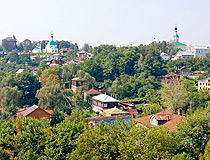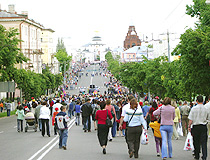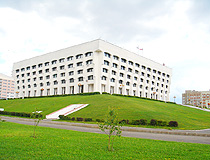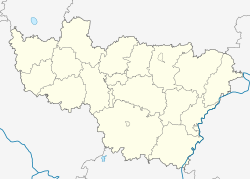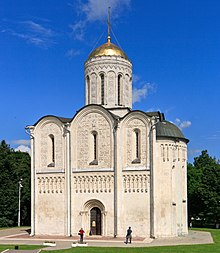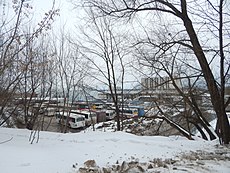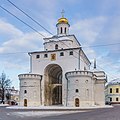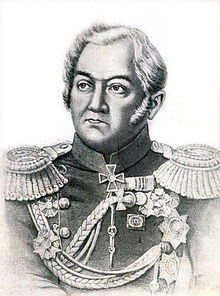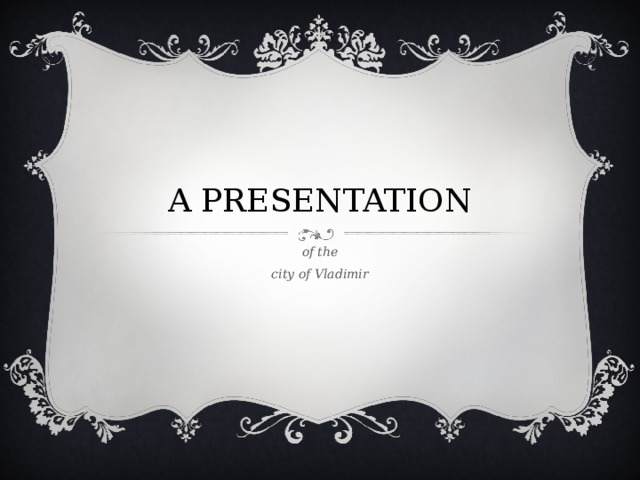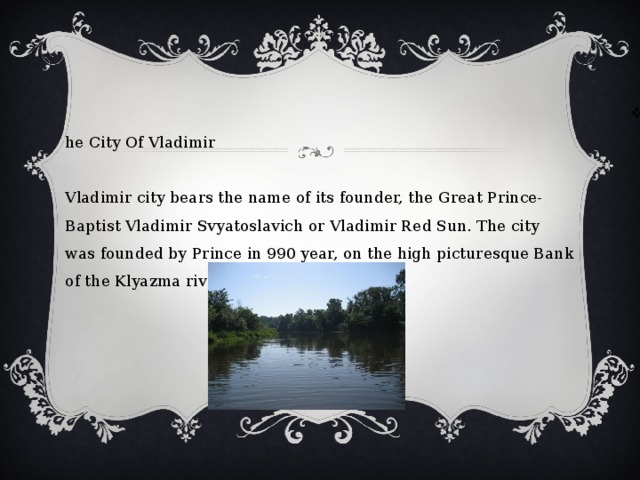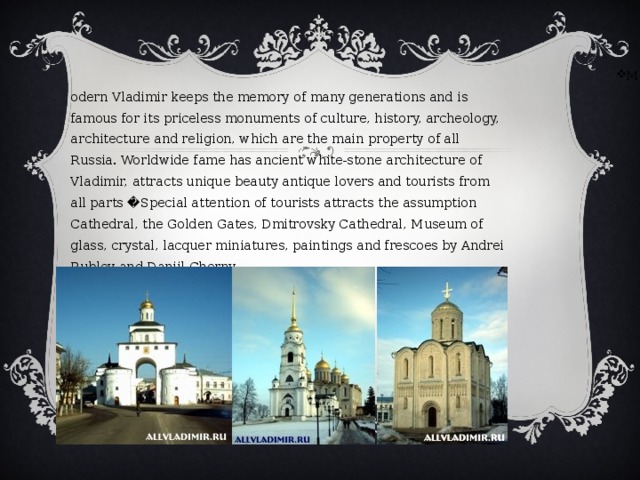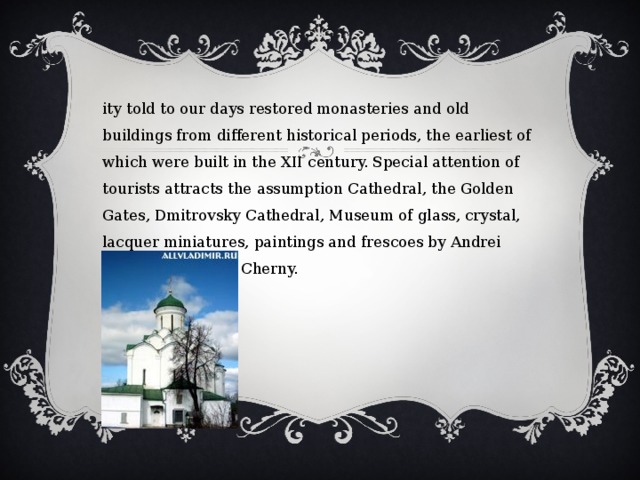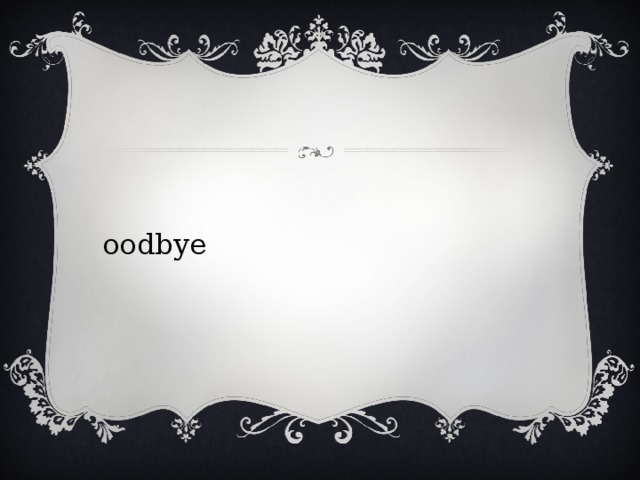The city was founded by Kiev Prince Vladimir Svyatoslavovich (the Great) in 990. – Город Владимир основан киевским князем Владимиром Святославовичем (Великим) в 990 году.
Vladimir is a city in Russia, the administrative center of the Vladimir region and the city district of Vladimir. – Владимир — город в России, административный центр Владимирской области и городского округа город Владимир.
The population of the city according to the all-Russian population census in 2018 was about 350 000 people. – Население города по свидетельству Всероссийской переписи населения на 2018 год составило около 350 000 человека.
Vladimir belongs to the zone with a temperate continental type of climate. – Владимир относится к зоне с умеренно-континентальным типом климата.
Weather conditions of the city are close to weather conditions of Moscow and Nizhny Novgorod. – Погодные условия города близки к погодным условиям Москвы и Нижнего Новгорода.
The only difference is that in Nizhny Novgorod falls slightly more precipitation. – Отличие заключается лишь в том, что в Нижнем Новгороде выпадает несколько больше атмосферных осадков.
City sights – Достопримечательности города
Assumption Cathedral is a complex of buildings of different times, the first of which began to be built in 1158, the Tomb of many representatives of the Vladimir Grand house. (Успенский собор представляет собой комплекс построек разного времени, первая из которых начала строиться в 1158 году Усыпальница многих представителей владимирского великокняжеского дома.)
The Golden gate was built in white stone in 1158-1164, playing the role of the main battle and travel tower of the fortress. (Золотые ворота были построены в из белого камня в 1158-1164 гг., играли роль главной боевой и проездной башни крепости.)
St. Demetrius Cathedral was founded in 1194 ,the distinctive features of which are the sculptural decorations covering the walls of the temple. (Дмитриевский собор был заложен в 1194 г. ,отличительными особенностями которого являются скульптурные украшения, покрывающие стены храма.)
The exhibition “Old Vladimir” is an exhibition and observation deck in the former water tower. (Выставка “Старый Владимир” – выставка и смотровая площадка в бывшей водонапорной башне.)
The monument to Prince Vladimir the Red Sun was erected in 2007 near the assumption Cathedral. (Памятник князю Владимиру Красное Солнышко установлен в 2007 году недалеко от Успенского собора.)
Water tower – a monument of engineering and industrial architecture of the early XX century. (Водонапорная башня — памятник инженерно-технической и промышленной архитектуры начала XX века.)
The city Duma – a monument of civil architecture of the early XX century, built in pseudo-Russian style on the Cathedral square near the assumption Cathedral. (Городская дума — памятник гражданской архитектуры начала XX века, построенный в псевдорусском стиле на Соборной площади рядом с Успенским собором.)
Historical Museum – a monument of history and architecture. (Исторический музей — памятник истории и архитектуры.)
Church Catholic Church of the late nineteenth century. (Костёл — католическая церковь конца XIX века.)
Museum of nature – the city Museum, which tells about the flora and fauna of the Vladimir region. (Музей природы — городской музей, рассказывающий о животном и растительном мире Владимирского края.)
“Chambers” is a cultural and educational complex, which includes a children’s Museum center and several mobile and permanent galleries and expositions. («Палаты» — культурно-образовательный комплекс, включающий в себя детский музейный центр и несколько передвижных и постоянных галерей и экспозиций.)
Planetarium — the planetarium of the city of Vladimir, located in the building of Nikolo-Kremlevskaya Church of the XVIII century. (Планетарий — городской планетарий Владимира, находится в здании Николо-Кремлёвской церкви XVIII века.)
Real school — a monument of history and architecture of the early XX century. (Реальное училище — памятник истории и архитектуры начала XX века.)
Shopping arcade a monument of urban planning, architecture and history of the late XVIII — early XX centuries. (Торговые ряды — памятник градостроительства, архитектуры и истории конца XVIII — начала XX веков.)
Trinity Church – old believer Church, built in the early XX century at the expense of local old believers. (Троицкая церковь — старообрядческий храм, построенный в начале XX века на средства местных староверов.)
Central Park – the main city Park of Vladimir. (Центральный парк — главный городской парк Владимира.)
Vladimir Central – prison, founded by Catherine II. (Владимирский централ — тюрьма, основанная при Екатерине II.)
History of Vladimir
Foundation of Vladimir
The first people began to settle in the territory of today’s Vladimir in the Paleolithic era, about 34 thousand years ago. In the 6th-7th centuries, the Volga-Finnish tribe of Merya settled here. In the 8th-10th centuries, on the hill where the Assumption Cathedral was later built, there had been a Meryan settlement. In the 9th-10th centuries, the Slavs began to settle here, in particular, the Krivichi.
There are two alternative years for the founding of Vladimir: 1108 and 990. In the Soviet period, the version was accepted that Vladimir had been founded by Prince Vladimir Monomakh around 1108. Accordingly, the 850th anniversary of the city was celebrated in 1958. In the 1990s, local historians, based on a number of chronicle sources, spoke in favor of another year of the city’s foundation — 990. And another Vladimir was named the founder of the city — Prince Vladimir Svyatoslavich, also known as Vladimir the Great (Christianized the Kievan Rus in 988).
Vladimir grew thanks to the princes Vladimir Monomakh (1053-1125) and Yuri Dolgoruky (1090-1157), who strengthened it as a stronghold for the defense of the Rostov-Suzdal principality. Prince Andrey Bogolyubsky (1111-1174) transferred the capital of the principality to Vladimir in 1157. In this town, as the new capital of North-Eastern Russia, the Assumption Cathedral was erected in 1158-1160. The Golden Gate (built around 1164) became the key point of the town’s defense.
Under the successors of Prince Andrei Bogolyubsky, the town expanded greatly. In Vladimir and neighboring Suzdal, the Vladimir-Suzdal icon-painting school was formed; the town had its own chronicle. The Vladimir principality reached its highest power during the reign of Prince Vsevolod the Big Nest (1176-1212), when the Cathedral of Saint Demetrius (1194-1197) was built.
More Historical Facts…
Vladimir in the 13th-17th centuries
In 1238, during the Mongol invasion of Rus’ (1237-1240), Vladimir was taken after a short siege and plundered. The princes of Vladimir were recognized in the Golden Horde by their status as the chief and oldest in all of Rus’. Vladimir remained the capital of the Russian lands. The status of the town increased in 1299, when it became the residence of the Russian metropolitans.
At the beginning of the 14th century, a struggle for control over the Vladimir principality unfolded between Tver, Suzdal and Moscow. In 1325, under Grand Duke of Moscow Ivan Kalita, Metropolitan Peter moved from Vladimir to Moscow, which strengthened the Moscow principality as a contender for the unifier of the Russian lands.
Subsequently, the Moscow prince Dmitry Donskoy (1350-1389) managed to achieve recognition of his hereditary rights to Vladimir from all neighboring princes and the Golden Horde, which meant his recognition as the Grand Duke of Vladimir and Moscow. This meant the annexation of the Vladimir lands to the Moscow principality.
In 1382, Vladimir, like other towns of North-Eastern Rus’, suffered from the invasion of Khan Tokhtamysh of the Golden Horde. In 1395, during the military campaign of Timur against Tokhtamysh, the miraculous and especially revered icon of the Vladimir Mother of God was brought to Moscow from Vladimir to protect it from the conqueror. The fact that the troops of Timur, for no apparent reason, turned back near Yelets (about 400 km south of Moscow), was regarded as the intercession of the Mother of God and the icon was not returned to Vladimir.
With the growth of Moscow, Vladimir turned into an ordinary provincial town. In 1614, the population of the town was only about 600 people.
Vladimir in the 18th — early 20th centuries
Some economic and cultural upsurge of Vladimir began at the end of the 18th century, when it became the administrative center of the Vladimir Governorate. In 1784, the population of Vladimir was about 2,500 people. In November 1797, the first printing house in Vladimir was opened, in January 1834 — the first provincial public library, in 1847 — a drama theater, in 1862 — a provincial museum of local lore.
In 1838-1840, Alexander Herzen, “the father of Russian socialism”, was in exile in Vladimir. In 1861, Vladimir was connected to Moscow by railway (Moscow-Nizhny Novgorod railway). In 1858, a telegraph began to operate in the town, in 1866, the construction of a water supply was completed, and in 1887, a telephone connection was established. In 1908, the first power plant was put into operation.
According to the first all-Russian census of 1897, 28,479 people lived in Vladimir: Russians — 26,436, Poles — 736, Ukrainians — 488, Jews — 399. At the end of the 19th century, a Lutheran church and a Catholic church were built in Vladimir.
At the turn of the centuries, the Russian Revival style of Russian architecture spread in Vladimir, the most striking examples of which were the Church of the Archangel Michael (1893) and the building of the Vladimir Historical Museum (1903). In 1914, the population of Vladimir was 47,020 people.
In the first years of Soviet power, many streets of Vladimir were renamed, most of the churches were closed and demolished. Two decades before World War II were the time of accelerated industrialization and the transformation of the city into a large industrial center.
On January 14, 1929, during the territorial and administrative reform, Vladimir became part of the newly formed Ivanovo Industrial Oblast. On March 5, 1932, the plant “Khimplastmass” (the Vladimir Chemical Plant) began operation. In 1939, the population of Vladimir was 66,797 people.
Vladimir during and after World War II
During the Second World War, Vladimir was one of the largest evacuation centers in the European part of the USSR. In 1941-1945, there were 18 evacuation hospitals in the city. In the fall of 1941, a lot of refugees came to Vladimir from Moscow and the Moscow region; they were leaving to the east from the German offensive. On August 14, 1944, Vladimir again became the center of a separate region — Vladimir Oblast.
In the first post-war years, there were three camps and a hospital for prisoners of war in Vladimir. The largest of them was Camp #190, which also had branches in the towns and villages of the region. In 1946, there were about 10 thousand people in this camp. By 1949, all prisoners of war returned to Germany.
After the war, large enterprises of machine-building, metal-working, electrical, instrument-making, chemical, and light industries were built in the city. In August 1958, a solemn celebration of the 850th anniversary of Vladimir took place. By the end of the 1950s, the city’s population exceeded 150 thousand people.
In 1960, the construction of an arched reinforced concrete bridge was completed — the first permanent bridge across the Klyazma, which made it possible to start the construction of a residential district (Zagorodny Park) and a regional hospital center on the right bank of the river.
In the early 1970s, Vladimir became one of the centers of the Golden Ring of Russia — a well-known tourist theme-route uniting several old Russian cities. In 1980, the population of Vladimir exceeded 300 thousand people.
Architecture of Vladimir
Cityscape of the old Vladimir
In the center of Vladimir on a holiday
Author: Boris Shmelyov
Vladimir Oblast Administration known as the White House
Author: Catherina Zhigunova
Vladimir — Features
In the past, such variants of the name of the city as Vladimir-on-Klyazma and Vladimir-Zalessky were also used in connection with the existence of the town of the same name in South-Western Rus’ (Vladimir-Volynsky in Volyn Oblast of today’s Ukraine).
Today’s coat of arms of Vladimir repeats its historical coat of arms with the following description: “In the red field, a lion standing on its hind legs with an iron crown on its head, holding a long silver cross in its front right paw.”
The oldest central part of Vladimir lies on the high left bank of the Klyazma River, on hills steeply descending to the river, separated by deep ravines. The Klyazma flows through the city for 2.5 km and another 5 km along the city border; the width of the river in Vladimir is about 130 m.
The climate in Vladimir is moderately continental. Winters are moderately cold, with alternating periods of frosts and thaws. Summers are warm, but relatively short, with occasional periods of extreme heat. The average temperature in January is minus 9.8 degrees Celsius, in July — plus 19.8 degrees Celsius.
Vladimir is an important industrial center of Central Russia. Large enterprises of machine-building, metal-working, electrical, instrument-making, chemical, light and food industries, and the construction industry operate in the city.
Public transport is represented by trolleybuses and buses. There are regular buses running from Vladimir to all district centers of Vladimir Oblast, as well as to Moscow, Ivanovo, Kostroma, Nizhny Novgorod, Ryazan, Yaroslavl, and other cities. Vladimir is connected by railway with Moscow and Nizhny Novgorod.
First and foremost Vladimir is a city-museum with unique historical and architectural monuments — three white-stone monuments of pre-Mongol architecture, recognized as a UNESCO World Heritage Site as part of the object “The white-stone monuments of Vladimir and Suzdal”. These are the Assumption Cathedral (1158-1189), Dmitrievsky Cathedral (1194-1197), and the Golden Gate (1158-1164).
In comparison with other cities of the “Golden Ring”, churches of the 17th-18th centuries in Vladimir are not so numerous. In architectural terms, the most interesting are the Church of the Assumption of the Blessed Virgin Mary (1649), Church of St. Nicholas the Wonderworker (1732-1735), and Church of the Beheading of John the Baptist (1762-1765), commonly known as Nikitskaya Church.
The pseudo-Gothic Catholic Church of St. Rosary, built in 1894, is worth mentioning among the monuments of the late 19th century. In total, there are more than 200 state-protected buildings of the 18th-19th centuries in Vladimir. After 1917, the historic city center was almost completely rebuilt.
Walking is the easiest and most comfortable way to explore Vladimir. Its compact historic center can be walked through in about 30-40 minutes. Souvenirs can be bought in one of the shops of the Trading Rows (Bolshaya Moskovskaya Street, 19), as well as from the stalls at the Golden Gate or the Dmitrievsky Cathedral. For authentic gifts, you should visit the shop at the Museum of Crystal and Lacquer Miniatures in the Trinity Church (Dvoryanskaya Street, 2).
You can buy souvenirs with images of Vladimir architectural monuments (plates, boxes, paintings, etc.), Pokrovsky gingerbread, Mstersk lacquer miniature, crystal from Gus-Khrustalny. Such birch bark products as boxes and sandals (lapti) are also popular, as well as all kinds of scarves, towels, patchwork, and stone jewelry.
Main Attractions of Vladimir
The Golden Gate (1158-1164) — one of the main symbols of Vladimir, the only one of the surviving gates in the earthen rampart that encircled old Vladimir. In the 12th century, this gate served as the main entrance for the prince and his retinue to the central part of the town. The Golden Gate got its name because in the past the gates were sheathed with gilded copper sheets. At the top of the structure there is a small chapel.
This unique example of the architecture of Kievan Rus’ is included in the program of sightseeing tours around Vladimir. In the upper part of the building, there is a military-historical exposition with weapons and military equipment from different times. Bolshaya Moskovskaya Street, 1a.
Holy Assumption Cathedral (1158-1189) — the main Orthodox church of Vladimir, an outstanding monument of the white-stone architecture of pre-Mongol Rus’. Historically, before the rise of Moscow, it was the main church of Vladimir-Suzdal Rus’ and served as a model for a number of later cathedrals, including the Assumption Cathedral in the Moscow Kremlin. It is one of the few churches in which the original frescoes by Andrei Rublev have survived. Bolshaya Moskovskaya Street, 56.
Cathedral of Saint Demetrius (1194-1197) — one of the greatest monuments of Russian church architecture of the pre-Mongol period, an excellent example of a white-stone church of the Vladimir-Suzdal architectural school. Consecrated in honor of the Christian martyr Demetrius of Thessaloniki, this cathedral is famous for its white stone carvings. Its walls are decorated with about 600 reliefs depicting saints, mythical and real animals. Outwardly, it resembles the famous Church of the Intercession on the Nerl located near Vladimir. Bolshaya Moskovskaya Street, 60.
Museum complex “Palaty” — a large three-storey building constructed in the classical architectural style in yellow and white colors. The first floor is reserved for exhibitions for children. The second floor is dedicated to the life of the nobility — “Charm of Bygone Days” (antique vases, old furniture, etc.). There is also an art gallery where you can see masterpieces of Russian painting from different times. The third floor is reserved for various exhibitions. Bolshaya Moskovskaya St, 58.
Vladimir Historical Museum — a beautiful two-story mansion built of red brick in the pseudo-Russian style in 1900-1906. The exposition of this museum is devoted to the history of the city and the region, from the prehistoric era to the present day. Here you will see archaeological finds, old jewelry and dishes, documents, church relics, picturesque portraits, and other genuine exhibits. Bolshaya Moskovskaya Street, 64.
Holy Trinity (“Red”) Church (1913-1916) — a former Old Believer church in Vladimir, built of red brick in the neo-Russian style. Today, the building is occupied by the museum “Crystal. Lacquer Miniature. Embroidery”. Its collection, which includes pre-revolutionary masterpieces and outstanding works of contemporary masters, brings together the best examples of traditional arts and crafts. Dvoryanskaya Street, 2.
Museum “Old Vladimir”. This museum occupies the building of a former water tower — a monument of provincial industrial architecture built in the pseudo-Gothic style in 1912. The exposition shows the life of Vladimir at the turn of the 19th-20th centuries — the interiors of the room of a wealthy citizen, a tavern with a traditional samovar, a police station, a church shop. On the top floor of the former water tower there is a great observation deck, from where almost all the main sights of Vladimir are perfectly visible. Kozlov Tupik Street, 14.
Church of the Holy Rosary of the Blessed Virgin Mary (1892-1894) — one of the most beautiful buildings in Vladimir, a majestic Catholic church built in the style of red-brick neo-Gothic. It was built due to the fact that there were quite a lot of exiled Poles and Lithuanians in Vladimir by the end of the 19th century. Divine services in Russian and concerts of organ music are held here, which everyone can enjoy. Gogolya Street, 12.
The Ferris Wheel “Sky 33” — one of the largest Ferris wheels in Russia with a height of 50 meters. From the top point, you can see up to 70% of the territory of Vladimir. The wheel has 32 indoor heated and air-conditioned cabins for up to 6 people and makes one circle in 15 minutes. You can enjoy the views of Vladimir from above in any weather. Mira Street, 36 (Central Park of Culture and Rest).
Church of the Beheading of John the Baptist (also known as the Nikitskaya Church) (1762-1765) — a picturesque tall three-story green-and-white church, an architectural monument of federal significance. The building of this church constructed in the provincial baroque style looks more like a noble residence, rather than a religious building. Knyagininskaya Street, 8.
Observation decks on Georgievskaya Street. Georgievskaya Street is a pedestrian alley in the center of Vladimir, along which a lot of city attractions are located. Locals call it “Vladimir Arbat”. There are two observation decks on this street, from where you can see the banks of the Klyazma River and the magnificent Holy Assumption Cathedral.
Church of the Intercession on the Nerl — one of the most beautiful and interesting Russian Orthodox churches, an outstanding monument of Vladimir-Suzdal architecture built in the middle of the 12th century. It is located about 1.5 km from the village of Bogolyubovo, 12 km north-east from the center of Vladimir.
This article is about the city in Russia. For other uses, see Vladimir.
|
Vladimir Владимир |
|
|---|---|
|
City[1] |
|
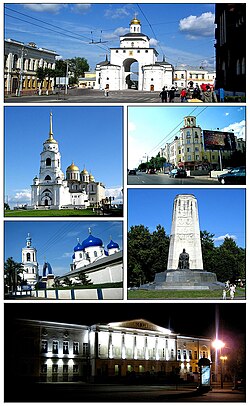
Views of Vladimir |
|
|
Flag Coat of arms |
|
| Anthem: none[3] | |
|
Location of Vladimir |
|
|
Vladimir Location of Vladimir Vladimir Vladimir (Vladimir Oblast) |
|
| Coordinates: 56°07′43″N 40°24′21″E / 56.12861°N 40.40583°ECoordinates: 56°07′43″N 40°24′21″E / 56.12861°N 40.40583°E | |
| Country | Russia |
| Federal subject | Vladimir Oblast[2] |
| First mentioned | 990 |
| Government | |
| • Body | Council of People’s Deputies[4] |
| • Head[4] | Andrey Shokhin[5] |
| Area
[6] |
|
| • Total | 124.59 km2 (48.10 sq mi) |
| Elevation | 150 m (490 ft) |
| Population
(2010 Census)[7] |
|
| • Total | 345,373 |
| • Estimate
(2018)[8] |
357,024 (+3.4%) |
| • Rank | 51st in 2010 |
| • Density | 2,800/km2 (7,200/sq mi) |
|
Administrative status |
|
| • Subordinated to | City of Vladimir[2] |
| • Capital of | Vladimir Oblast[2], City of Vladimir[2] |
|
Municipal status |
|
| • Urban okrug | Vladimir Urban Okrug[9] |
| • Capital of | Vladimir Urban Okrug[9] |
| Time zone | UTC+3 (MSK |
| Postal code(s)[11] |
600000, 600001, 600003, 600005–600009, 600014–600018, 600020–600028, 600031–600033, 600035–600038, 600700, 600950, 600960, 600970, 600980, 600999, 992800 |
| Dialing code(s) | +7 4922 |
| OKTMO ID | 17701000001 |
| City Day | The first Sunday of September |
| Website | www.vladimir-city.ru |
Vladimir (Russian: Влади́мир, IPA: [vlɐ’dʲimʲɪr] (listen)) is a city and the administrative center of Vladimir Oblast, Russia, located on the Klyazma River, 200 kilometers (120 mi) east of Moscow. It is served by a railway and the M7 motorway. Population: 349,951 (2021 Census);[12] 345,373 (2010 Census);[7] 315,954 (2002 Census);[13] 349,702 (1989 Census).[14]
History[edit]
Vladimir was one of the medieval capitals of Russia, with significant buildings surviving from the 12th century. Two of its Russian Orthodox cathedrals, a monastery, and associated buildings have been designated as among the White Monuments of Vladimir and Suzdal, a UNESCO World Heritage Site. In the past, the city was also known as Vladimir-on-Klyazma (Владимир-на-Клязьме)[15] and Vladimir-Zalessky (Владимир-Залесский), to distinguish it from another Vladimir in Volhynia (modern Ukraine).
Foundation[edit]
The founding date of Vladimir is disputed between 990 and 1108. In the Novgorod First Chronicle, Vladimir is mentioned under the year 1108, and during the Soviet period, this year was decreed to be its foundation year with the view that attributes the founding of the city, and its name, to Vladimir Monomakh, who inherited the region as part of the Rostov-Suzdal Principality in 1093.[16] It is named there as Volodimer.[17] The chronicles also describe how inhabitants from neighbouring towns, namely Suzdal and Rostov, alluded to Vladimir as a young town.[18] Accordingly, the 850th anniversary of the city foundation was celebrated in 1958, with many monuments from the celebrations adorning the city; this enabled Nikita Khrushchev, who recently took power in the Soviet Union, to link his administration with early Russian history.
In the 1990s, a new opinion developed that the city was instead founded in 990 by Vladimir the Great, with local historians supporting the alternative foundation date and citing various chronicle sources.[19][20] Scholars reinterpreted certain passages in the Hypatian Codex, which mentions that the region was visited by Vladimir the Great, the «father» of Russian Orthodoxy, in 990, so as to move the city foundation date to that year. The Charter of Vladimir, the basic law of the city passed in 2005, explicitly mentions 990 as the date of the city’s foundation.[21][22] The city administration officially recognizes 990 as the foundation date.[23]
Vladimir-Suzdal[edit]
The city’s most historically significant events occurred after the turn of the 12th century. Serving its original purpose as a defensive outpost for the Rostov-Suzdal Principality, Vladimir had little political or military influence throughout the reign of Vladimir Monomakh (1113–1125), or his son Yury Dolgoruky («Far-Reaching») (1154–1157).
St. Demetrius’ Cathedral, shown on this 2017 photo, is famous for its masterfully carved exterior, representing the Biblical story of King David.
Under Dolgoruky’s son, Andrey Bogolyubsky (1157–1175) (also known as Andrew the Pious), the city became the center of the Vladimir-Suzdal Principality. It had a Golden Age, which lasted until the Mongol invasion of Rus’ in 1237. During this time, Vladimir enjoyed immense growth and prosperity. Andrey oversaw the building of the city’s Golden Gates and the Dormition Cathedral. In 1164, Andrey attempted to establish a new metropolitanate in Vladimir, separate from that of Kiev. He was rebuffed by the Patriarch of Constantinople.[24]
Scores of Russian, German, and Georgian masons worked on Vladimir’s white stone cathedrals, monastery, towers, and palaces. Unlike any other northern buildings, their exterior was elaborately carved with high relief stone sculptures. Only three of these edifices stand today: the Dormition Cathedral, the Cathedral of Saint Demetrius, and the Golden Gate. They are included among the White Monuments of Vladimir and Suzdal, designated as a UNESCO World Heritage Site.
During Andrey’s reign, a royal palace in Bogolyubovo was built, as well as the world-famous Church of the Intercession on the Nerl, now considered one of the jewels of ancient Russian architecture. Andrey was assassinated at his palace at Bogolyubovo in 1175.
Drawing of Mongols of the Golden Horde outside Vladimir presumably demanding submission before sacking the city
Vladimir was besieged by the Mongol-Tatars of the Golden Horde under Batu Khan. It was finally overrun on February 8, 1238. A great fire destroyed thirty-two limestone buildings on the first day alone, while the grand prince’s family perished in a church where they sought refuge from the flames. The grand prince escaped, but was killed at the Battle of the Sit River the following month.
Grand Duchy of Moscow[edit]
After the Mongols, Vladimir never fully recovered. The most important Rus prince (usually the Prince of Moscow, but sometimes a Tver or another principality) was styled the Grand Prince of Vladimir, but the title had become an honorific symbol of majesty. From 1299 to 1325, the city was seat of the metropolitans of Kiev and All Rus’, until Metropolitan Peter moved the See to Moscow in 1325.
The Grand Princes of Vladimir were originally crowned in Vladimir’s Assumption Cathedral, but when Moscow superseded Vladimir in the 14th Century as the seat of the Grand Prince, the Assumption Cathedral in the Moscow Kremlin became the site of their coronation. The Moscow cathedral was loosely copied by the Italian architect Aristotele Fioravanti from Vladimir’s original.
After the rise of Moscow, Grand Princes of Moscow continued to build several new churches in Vladimir. Notable examples include the Annunciation Church at Snovitsy (ca. 1501), three kilometers northwest of the city, and a church in the Knyaginin Nunnery (ca. 1505), which today includes murals dating from 1648.
Imperial Russia[edit]
A view of Vladimir in 1911
Remains of the prince-saint Alexander Nevsky were kept in the ancient Nativity Abbey of Vladimir until 1703, when Peter the Great had them transferred to the Monastery (now Lavra) of Alexander Nevsky in St. Petersburg. The Nativity Church (built from 1191 to 1196) collapsed several years later, after workmen tried to fashion more windows in its walls in an effort to brighten the interior.
The city was the center of Vladimir Province [ru], part of Moscow Governorate from its establishment by Peter the Great in 1708. Vladimir was separated from Moscow Governorate and made the center of a new Vladimir Viceroyalty [ru] by a ukase of Catherine the Great in 1778. In 1796, Paul I’s administrative reform transformed the viceroyalty into the Vladimir Governorate [ru] in the same borders.
In the years 1838-1840, Alexander Herzen was exiled in Vladimir, passing through the city on the infamous Vladimirka.
In December 1858 the city began to operate telegraph. On June 14, 1861,[25] the Moscow–Nizhny Novgorod Railway [ru] began to operate through Vladimir. In 1866, construction of a running water supply was completed, with telephone lines being put up in 1887 and the first electrical power lines on December 5, 1908.
In November 29, 1898 Vladimir provincial scientific archival commission was established.
Soviet Union[edit]
After the establishment of Soviet power, many streets were renamed in Vladimir; most of the parish churches were closed and condemned to be demolished.
In the first decades of Soviet rule industrialization occurred in Vladimir. On January 14, 1929, the Vladimir Governorate was abolished and the city became part of the newly formed Ivanovo Industrial Oblast.
On August 14, 1944, Vladimir became the administrative center of a new Vladimir Oblast carved from Ivanovo Oblast. In 1950 from the basis of the teachers’ institute the Vladimir Pedagogical Institute was created. On November 5, 1952 the first trolleybus line began to operate in the city.
In 1958 the Vladimir–Suzdal Museum and Reserve [ru] was created, composed of a group of unique architectural monuments of Russian defense and church architecture. The monuments are located in three cities—Vladimir, Suzdal and Gus-Khrustalny—as well as villages of Bogolyubovo and Kideksha.
Architecture of the Soviet period is represented by such structures as building complexes and polytechnic colleges, the Torpedo Stadium (built 1952), a reinforced concrete arch bridge over the river Klyaz’ma (1960), the Hotel Vladimir (1956), the Drama Theatre (1971) and others. In 1971 the city was awarded the Order of Red Banner of Labor.
Administrative and municipal status[edit]
Vladimir is the administrative center of the oblast.[2] Within the framework of administrative divisions, it is, together with seventeen rural localities, incorporated as the City of Vladimir—an administrative unit with the status equal to that of the districts.[2] As a municipal division, the City of Vladimir is incorporated as Vladimir Urban Okrug.[9]
Economy and military[edit]
Vladimir is home to several electrical and chemical factories, several food processing plants and two large thermal power stations. Tourism related to the historical sites is a major contributor to the city economy.
The headquarters of the 27th Guards Rocket Army of the Strategic Missile Troops is located in the city. During the Cold War, Vladimir was host to the Dobrynskoye air force base.
Transportation[edit]
A view to railway station and a bus terminal
Since 1861, there has been a railway connection between Vladimir and Moscow.[26] Vladimir is also linked to Moscow and Nizhny Novgorod by the M7 highway. Local transport includes buses, trolleybuses, fixed-route minivans, and taxis.
Vladimir bus service links the city to all the district centers of Vladimir Oblast, as well as Moscow, Ivanovo, Kostroma, Nizhny Novgorod, Ryazan, Yaroslavl and other cities.
At least 20 pairs of long-distance trains pass daily through Vladimir station, giving Vladimir year-round direct rail links to Moscow (Kursk Station), St. Petersburg and Nizhny Novgorod. Since the summer of 2010 Vladimir (on the Nizhny Novgorod line) is a stopping point for the «Peregrine Falcon» high-speed train.
Developed suburban rail: Vladimir was the only city in Russia with concurrent commuter trains two Russian cities with subways.[citation needed]
The city is served by the Semyazino Airport 5 km west of the city center.
Gallery[edit]
-
Vladimir railway station, August 2008
-
-
Trolza-5275 low-entry trolleybus
-
A trolleybus route #1
-
A bus route #26
-
The bus terminal in Vladimir
Climate[edit]
Vladimir experiences a humid continental climate (Köppen climate classification Dfb) with long, cold winters and short, warm summers.
| Climate data for Vladimir (1991–2020, extremes 1902–present) | |||||||||||||
|---|---|---|---|---|---|---|---|---|---|---|---|---|---|
| Month | Jan | Feb | Mar | Apr | May | Jun | Jul | Aug | Sep | Oct | Nov | Dec | Year |
| Record high °C (°F) | 7.1 (44.8) |
9.5 (49.1) |
17.8 (64.0) |
27.8 (82.0) |
34.0 (93.2) |
35.2 (95.4) |
37.1 (98.8) |
36.5 (97.7) |
29.5 (85.1) |
25.0 (77.0) |
14.8 (58.6) |
12.0 (53.6) |
37.1 (98.8) |
| Average high °C (°F) | −5.5 (22.1) |
−4.4 (24.1) |
1.8 (35.2) |
11.1 (52.0) |
19.1 (66.4) |
22.2 (72.0) |
24.6 (76.3) |
22.6 (72.7) |
16.3 (61.3) |
8.2 (46.8) |
0.3 (32.5) |
−3.8 (25.2) |
9.4 (48.9) |
| Daily mean °C (°F) | −8.3 (17.1) |
−7.7 (18.1) |
−2.3 (27.9) |
5.8 (42.4) |
13.0 (55.4) |
16.6 (61.9) |
19.0 (66.2) |
16.9 (62.4) |
11.4 (52.5) |
4.9 (40.8) |
−1.9 (28.6) |
−6.1 (21.0) |
5.1 (41.2) |
| Average low °C (°F) | −10.9 (12.4) |
−10.6 (12.9) |
−5.6 (21.9) |
1.4 (34.5) |
7.7 (45.9) |
11.7 (53.1) |
14.1 (57.4) |
12.3 (54.1) |
7.7 (45.9) |
2.4 (36.3) |
−3.8 (25.2) |
−8.4 (16.9) |
1.5 (34.7) |
| Record low °C (°F) | −39.7 (−39.5) |
−36.1 (−33.0) |
−30.0 (−22.0) |
−16.1 (3.0) |
−8.0 (17.6) |
−0.1 (31.8) |
3.9 (39.0) |
0.0 (32.0) |
−6.3 (20.7) |
−18.9 (−2.0) |
−27.2 (−17.0) |
−43.0 (−45.4) |
−43.0 (−45.4) |
| Average precipitation mm (inches) | 40 (1.6) |
33 (1.3) |
29 (1.1) |
36 (1.4) |
46 (1.8) |
71 (2.8) |
65 (2.6) |
54 (2.1) |
50 (2.0) |
55 (2.2) |
45 (1.8) |
39 (1.5) |
563 (22.2) |
| Average extreme snow depth cm (inches) | 28 (11) |
41 (16) |
35 (14) |
5 (2.0) |
0 (0) |
0 (0) |
0 (0) |
0 (0) |
0 (0) |
0 (0) |
6 (2.4) |
17 (6.7) |
41 (16) |
| Average rainy days | 5 | 3 | 6 | 12 | 15 | 17 | 15 | 15 | 16 | 16 | 10 | 5 | 135 |
| Average snowy days | 26 | 23 | 16 | 6 | 1 | 0 | 0 | 0 | 1 | 6 | 18 | 25 | 122 |
| Average relative humidity (%) | 86 | 82 | 76 | 71 | 67 | 73 | 76 | 79 | 82 | 85 | 88 | 87 | 79 |
| Source: Pogoda.ru.net[27] |
Sightseeing[edit]
Modern Vladimir is a part of the Golden Ring of ancient Russian cities and a popular tourist destination. Its three chief monuments, White Monuments of Vladimir and Suzdal, inscribed by UNESCO on the World Heritage List, are the following:
- The magnificent five-domed Dormition Cathedral was designed as the burial place of grand princes and dedicated to the holy icon the Theotokos of Vladimir, which had been brought to the city by Andrey Bogolyubsky. The cathedral was constructed in 1158–1160, expanded in 1185–1189, and painted by the great Andrei Rublev and Daniil Chyorny in 1408. In 1810, a lofty bell-tower was added in Neoclassical style.
- The helmet-domed Cathedral of Saint Demetrius was built in 1194–1197 as a private chapel of Vsevolod the Big Nest in the courtyard of his palace and was consecrated to his holy patron, St. Demetrius. For all its formal unity, the cathedral represents an international project of Russian and Byzantine masters, Friedrich Barbarossa’s masons, and carvers sent by Queen Tamar of Georgia.
- The Golden Gate, originally a tower over the city’s main gate, was built in 1158–1164. The gate acquired its present form after having been reconstructed in the late 18th century, to prevent the dilapidated structure from tumbling down.
Other remarkable monuments of pre-Mongol Russian architecture are scattered in the vicinity. For more information on them, see Suzdal, Yuriev-Polsky, Bogolyubovo, and Kideksha.
-
View of Vladimir
-
Public park in Vladimir
-
Assumption Cathedral
-
Cathedral of Saint Demetrius
-
Golden Gate
Education[edit]
Vladimir is the site of the following education establishments:
- Vladimir State University
- Vladimir branch of the Russian Academy of National Economy and Public Administration
- Vladimir branch of Financial University under the Government of the Russian Federation
- Vladimir branch of the Russian University of Cooperation
- Vladimir Law Institute under the Ministry of Justice
- Vladimir Business Institute
- Vladimir Aviation Mechanics College
- Vladimir Pedagogical College
- Vladimir Polytechnic College
- Vladimir Basic Medical College
- Vladimir Construction College
- Vladimir Regional College of Music
- Vladimir Economy and Technology College
- Vladimir College of Technology
- Vladimir Industrial College
- Vladimir Chemical and Mechanical College
- College of Innovative Technologies and Entrepreneurship at Vladimir State University
Vladimir is also home to the Federal Centre for Animal Health and Welfare.
Sports[edit]
The city association football team, FC Torpedo Vladimir, currently plays in the second tier of Russian football having entered the league after seventeen years of competing in Russian third and fourth tiers.
Vladimir VC (previously known as Skat and Dinamo Vladimir) represents the city in Volleyball Major League B – Zone Europe. Vladimir is also home to Polaris-Vladimir ice hockey club, which competes in regional hockey competitions and Russian minor leagues, and Luch, which has both male and female table-tennis teams.
Twin towns – sister cities[edit]
Vladimir is twinned with:[28]
Anghiari, Italy
Antalya, Turkey
Babruysk, Belarus
Baoji, China
Bloomington, United States
Bukhara, Uzbekistan
Campobasso, Italy
Canterbury, England, United Kingdom
Chongqing, China
Erlangen, Germany
Gagra, Georgia
Haikou, China
Kardzhali, Bulgaria
Karlovo, Bulgaria
Kerava, Finland
Khujand, Tajikistan
Leninsky (Minsk), Belarus
Normal, United States
Saintes, France
Sarasota, United States
Skive, Denmark
Vawkavysk, Belarus
- Former twin towns, terminated in 2022 due to the Russian invasion of Ukraine
Notable people[edit]
- Valentin Afonin, association football player
- Yuri Lodigin, association football player
- Nikolai Andrianov, gymnast
- Vladimir Artemov, gymnast
- Aleksey Batalov, actor
- Mikhail Lazarev, admiral
- Yuri Levitan, radio announcer
- Anna Loginova, fashion model
- Alexey Prokurorov, cross-country skier
- Yuri Ryazanov, gymnast
- Vasily Shulgin, politician
- Mikhail Speransky, statesman
- Aleksandr Stoletov, physicist
- Nikolai Stoletov, general
- Sergei Taneyev, composer
- Dmitri Vyazmikin, association football player
- Venedikt Yerofeyev, writer
- Denis Yevsikov, association football player
- Nikolay Zhukovsky, scientist
References[edit]
Notes[edit]
- ^ Resolution #433
- ^ a b c d e f Law #130-OZ
- ^ Article 7 of the Charter of Vladimir states that the city may have an anthem, providing a decision is reached by the Council of People’s Deputies. As of 2015, no such decision has been made.
- ^ a b Charter of Vladimir, Article 23
- ^ Official website of Vladimir. Shokhin Andrey Stanislavovich, Head of the City of Vladimir (in Russian)
- ^ Управление Федеральной службы государственной регистрации, кадастра и картографии по Владимирской области. Доклад о состоянии и использовании земель Владимирской области в 2011 году. Город Владимир, форма 22[dead link] (in Russian)
- ^ a b Russian Federal State Statistics Service (2011). Всероссийская перепись населения 2010 года. Том 1 [2010 All-Russian Population Census, vol. 1]. Всероссийская перепись населения 2010 года [2010 All-Russia Population Census] (in Russian). Federal State Statistics Service.
- ^ «26. Численность постоянного населения Российской Федерации по муниципальным образованиям на 1 января 2018 года». Federal State Statistics Service. Retrieved January 23, 2019.
- ^ a b c Law #189-OZ
- ^ «Об исчислении времени». Официальный интернет-портал правовой информации (in Russian). June 3, 2011. Retrieved January 19, 2019.
- ^ Почта России. Информационно-вычислительный центр ОАСУ РПО. (Russian Post). Поиск объектов почтовой связи (Postal Objects Search) (in Russian)
- ^ Russian Federal State Statistics Service. Всероссийская перепись населения 2020 года. Том 1 [2020 All-Russian Population Census, vol. 1] (XLS) (in Russian). Federal State Statistics Service.
- ^ Russian Federal State Statistics Service (May 21, 2004). Численность населения России, субъектов Российской Федерации в составе федеральных округов, районов, городских поселений, сельских населённых пунктов – районных центров и сельских населённых пунктов с населением 3 тысячи и более человек [Population of Russia, Its Federal Districts, Federal Subjects, Districts, Urban Localities, Rural Localities—Administrative Centers, and Rural Localities with Population of Over 3,000] (XLS). Всероссийская перепись населения 2002 года [All-Russia Population Census of 2002] (in Russian).
- ^ Всесоюзная перепись населения 1989 г. Численность наличного населения союзных и автономных республик, автономных областей и округов, краёв, областей, районов, городских поселений и сёл-райцентров [All Union Population Census of 1989: Present Population of Union and Autonomous Republics, Autonomous Oblasts and Okrugs, Krais, Oblasts, Districts, Urban Settlements, and Villages Serving as District Administrative Centers]. Всесоюзная перепись населения 1989 года [All-Union Population Census of 1989] (in Russian). Институт демографии Национального исследовательского университета: Высшая школа экономики [Institute of Demography at the National Research University: Higher School of Economics]. 1989 – via Demoscope Weekly.
- ^ Vladimir-on-Klyazma at the Brockhaus and Efron Encyclopedic Dictionary.
- ^ Воронин Н. Н. Из ранней истории Владимира и его округи. // Советская археология. — 1959. — № 4. — С. 74—81.
- ^ Larin, S. (January 1, 1958). Gorod Vladimir [1108-1958]: istoriko-ėkonomicheskiĭ ocherk (in Russian). Владимирское книжное изд-во.
- ^ Новгородская первая летопись старшего и младшего изводов. — М.—Л.: Академия наук СССР, 1950. — С. 467.
- ^ К вопросу о дате основания г. Владимира. / Ред. С. В. Шевченко. — Владимир: Местное время, 1992.
- ^ Из письма академика Лихачёва Дмитрия Сергеевича. Институт русской литературы (Пушкинский Дом).
- ^ Charter of Vladimir, Article 3.
- ^ «ИСТОРИЧЕСКАЯ СПРАВКА». vladimir-city.ru.
- ^ Письмо администрации города Владимира № 01-01-419 от 26 мая 2016 г.
- ^ Janet Martin, Medieval Russia: 980-1584 (Cambridge: Cambridge UP, 1995), 100.
- ^ «History of Russian rail lines | Russian Railways». eng.rzd.ru. Archived from the original on March 4, 2016.
- ^ Train Station in Vladimir (in Russian)
- ^ «Weather and Climate — Vladimir Climate» (in Russian). Weather and Climate (Погода и климат). Retrieved November 8, 2021.
- ^ «От Усти-на-Лабе до Карлово: зачем Владимиру города-побратимы?». provladimir.ru (in Russian). Pro Vladimir. August 6, 2019. Retrieved February 2, 2020.
- ^ «Zrywamy współpracę z rosyjskim Vladimirem» (in Polish). Retrieved March 27, 2022.
- ^ «Partnerská města» (in Czech). City of Ústí nad Labem. Retrieved August 6, 2022.
Sources[edit]
- Администрация Владимирской области. Постановление №433 от 13 июня 2007 г. «О реестре административно-территориальных образований и единиц Владимирской области», в ред. Постановления №169 от 5 марта 2015 г. «О внесении изменения в Постановление Губернатора области от 13.06.2007 №433 «О реестре административно-территориальных образований и единиц Владимирской области»». Вступил в силу со дня официального опубликования. Опубликован: «Владимирские ведомости», №114, 20 июня 2007 г. (Administration of Vladimir Oblast. Resolution #433 of June 13, 2007 On the Registry of the Administrative-Territorial Formations and Units of Vladimir Oblast, as amended by the Resolution #169 of March 5, 2015 On Amending Resolution #433 of the Oblast Governor of June 13, 2007 «On the Registry of the Administrative-Territorial Formations and Units of Vladimir Oblast». Effective as of the day of the official publication.).
- Законодательное Собрание Владимирской области. Закон №130-ОЗ от 10 декабря 2001 г. «Об административно-территориальном устройстве Владимирской области и о порядке его изменения», в ред. Закона №22-ОЗ от 18 марта 2014 г. «О признании утратившими силу части 1 статьи 15 Закона Владимирской области «Об административно-территориальном устройстве Владимирской области и о порядке его изменения» и пункта 3 статьи 1 Закона Владимирской области «О внесении изменений в Закон Владимирской области «Об административно-территориальном устройстве Владимирской области и о порядке его изменения»». Вступил в силу со дня официального опубликования (13 декабря 2001 г.). Опубликован: «Владимирские ведомости», №232, 13 декабря 2001 г. (Legislative Assembly of Vladimir Oblast. Law #130-OZ of December 10, 2001 On the Administrative-Territorial Structure of Vladimir Oblast and on Procedures for Its Change, as amended by the Law #22-OZ of March 18, 2014 On Abrogating Part 1 of Article 15 of the Law of Vladimir Oblast «On the Administrative-Territorial Structure of Vladimir Oblast and on Procedures for Its Change» and Item 3 of Article 1 of the Law of Vladimir Oblast «On Amending the Law of Vladimir Oblast «On the Administrative-Territorial Structure of Vladimir Oblast and on Procedures for Its Change». Effective as of the day of the official publication (December 13, 2001).).
- Законодательное Собрание Владимирской области. Закон №189-ОЗ от 26 ноября 2004 г. «О наделении статусом городского округа муниципального образования город Владимир Владимирской области», в ред. Закона №108-ОЗ от 10 августа 2009 г «О внесении изменений в Закон Владимирской области «О наделении статусом городского округа муниципального образования город Владимир Владимирской области»». Вступил в силу со дня официального опубликования (1 декабря 2004 г.). Опубликован: «Владимирские ведомости», №333, 1 декабря 2004 г. (Legislative Assembly of Vladimir Oblast. Law #189-OZ of November 26, 2004 On Granting Urban Okrug Status to the Municipal Formation of the City of Vladimir of Vladimir Oblast, as amended by the Law #108-OZ of August 10, 2009 On Amending the Law of Vladimir Oblast «On Granting Urban Okrug Status to the Municipal Formation of the City of Vladimir of Vladimir Oblast». Effective as of the day of the official publication (December 1, 2004).).
- Владимирский городской Совет народных депутатов. Решение №231 от 29 июня 2005 г. «Устав муниципального образования город Владимир», в ред. Решения №157 от 26 августа 2015 г. «О внесении изменений в Устав муниципального образования город Владимир». Вступил в силу 4 августа 2005 г. (за исключением отдельных положений, вступающих в силу в иные сроки). Опубликован: «Владимирские ведомости», №251–252, 4 августа 2005 г. (Vladimir City Council of People’s Deputies. Decision #231 of June 29, 2005 Charter of the Municipal Formation of the City of Vladimir, as amended by the Decision #157 of August 26, 2015 On Amending the Charter of the Municipal Formation of the City of Vladimir. Effective as of August 4, 2005 (except for certain clauses which take effect on different dates).).
Further reading[edit]
- Trudy Ring, ed. (1995). «Vladimir». International Dictionary of Historic Places: Northern Europe. FitzroyDearborn. ISBN 978-1-136-63944-9. Retrieved April 4, 2016.
- Craft Brumfield, William (2004). A History of Russian Architecture. Seattle: University of Washington Press. ISBN 978-0-295-98394-3.
External links[edit]
Wikivoyage has a travel guide for Vladimir.
- Tourism portal of the Vladimir region, Russia
- Official website of Vladimir Archived March 11, 2011, at the Wayback Machine (in Russian)
- «Vladimir (town)» . Encyclopædia Britannica. Vol. 28 (11th ed.). 1911. p. 169.
- Tourist information on Vladimir
- The American Home in Vladimir
Vladimir (Part 1) Мorozova L.A
Vladimir (Part 1)
Мorozova L.A., Molochno-Dvorskaya School
Tula region
Founded in 990 by the Kiev prince
Founded in 990 by the Kiev prince Vladimir Svyatoslavich (Red Sun)
Оne of the most beautiful and ancient
Оne of the most beautiful and ancient Russian cities is Vladimir. Vladimir is more than 1,000 years old. It was founded by the prince Vladimir Svyatoslavovich in 990. It is located in the heart of the historic Vladimir region (Vladimirskaya Oblast) in 180 kilometers northeast of Moscow on the bank of the Klyazma River.
Now Vladimir is one of the cities of the Golden Ring, which attracts a lot of tourists from all over the world by its historic sights and museums. The main of them are the magnificent five-domed Assumption Cathedral, Dmitrievsky Cathedral, the Golden Gate.
Vladimir is a modern city at a time. It is a political, economic, scientific and cultural city of the Vladimirskaya Oblast and Russia as well. Vladimir is home to several electrical and chemical factories, several food processing plants, two large thermal power stations. A lot of institutes, academies and the university are located here.
Vladimir.
Map of Vladimir region The city of
Map of Vladimir region
The city of Vladimir is located in the central region of Russia, 180 km north-east of Moscow. A large transport highway connecting Moscow and Nizhny Novgorod passes through the city.
Coat of arms of the city of Vladimir
Coat of arms of the city of Vladimir
HISTORY OF THE COAT OF ARMS The coat of arms of Vladimir is a historical and cultural monument with ancient historical roots. Back in the XII century, the image of a leopard beast was a patrimonial mark of the Vladimir princes, an attribute of a strong power capable of overcoming the feudal fragmentation of Russia. Since the 17th century, the coat of arms of Vladimir has been a symbol of urban sovereignty, an indicator of the development of urban organization. The Great State Book of 1672 «Titular» contains the first description of the coat of arms of the city of Vladimir.
DESCRIPTION OF THE EMBLEM In a red field, a lion standing on its hind legs, having an iron crown on its head, holds a long silver cross in its front right paw. «
Sights of the city of Vladimir
Sights of the city of Vladimir Успенский собор
The Assumption Cathedral was built as the central cathedral of the capital of north-eastern Russia, which at that time became the city of Vladimir. The beginning of the construction of the cathedral dates back to 1158.
Презентация на англ яз по теме «Города России. Владимир. часть 1»
Monument to the baptists of the
Monument to the baptists of the Vladimir land, the founder of the city . The monument was erected on July 28, 2007 in honor of the 850th anniversary of the transfer of the capital of Russia from Kiev to Vladimir.
Observation deck
Observation deck
Dmitrievsky Cathedral, built in 1193-1197
Dmitrievsky Cathedral, built in 1193-1197.
Мonument to Andrei Rublev Monument by the
Мonument to Andrei Rublev
Monument by the Moscow sculptor O.K. Komova was opened in August 1995 for the millennium of the city of Vladimir. The location of the monument is not accidental, because in the Assumption Cathedral, located nearby, a large number of the master’s frescoes have been preserved.
Golden Gate is one of the most ancient and famous architectural monuments of
Golden Gate is one of the most ancient and famous architectural monuments of Vladimir
Golden Gate
Puppet show
Puppet show
Railway station building The official opening of traffic on
Railway station building
The official opening of traffic on Vladimir station took place on June 14, 1861. On this day, a passenger train was sent to Moscow, consisting of four cars and ten platforms.
Bridge over the Кlyazma river The bridge was opened in 1960 and is named in honor of the 850th anniversary of
Bridge over the Кlyazma river
The bridge was opened in 1960 and is named in honor of the 850th anniversary of Vladimir.
Презентация на англ яз по теме «Города России. Владимир. часть 1»
Владимир – жемчужина маршрута Золотого Кольца России. Это древний город, который несет огромную историческую ценность для всей страны. Здесь происходило формирование российского государства. Какое то время Владимир был столицей Руси. Владимир основал великий князь — Владимир Красное Солнышко, согласно летописи в 990 году.
Вы уже знаете о суперспособностях современного учителя?
Тратить минимум сил на подготовку и проведение уроков.
Быстро и объективно проверять знания учащихся.
Сделать изучение нового материала максимально понятным.
Избавить себя от подбора заданий и их проверки после уроков.
Наладить дисциплину на своих уроках.
Получить возможность работать творчески.
Просмотр содержимого документа
«Презентация по английскому языку на тему «Город-Владимир». »
A PRESENTATION
of the
city of Vladimir
- The City Of Vladimir Vladimir city bears the name of its founder, the Great Prince-Baptist Vladimir Svyatoslavich or Vladimir Red Sun. The city was founded by Prince in 990 year, on the high picturesque Bank of the Klyazma river.
- In its thousand year history of Vladimir went through periods of prosperity, decline and destruction, which in turn were replaced at times of honor and glory. In the history of the Russian state Vladimir played a critical role as the capital of North-Eastern Russia more than two hundred and fifty years
- Modern Vladimir keeps the memory of many generations and is famous for its priceless monuments of culture, history, archeology, architecture and religion, which are the main property of all Russia. Worldwide fame has ancient white-stone architecture of Vladimir, attracts unique beauty antique lovers and tourists from all parts �Special attention of tourists attracts the assumption Cathedral, the Golden Gates, Dmitrovsky Cathedral, Museum of glass, crystal, lacquer miniatures, paintings and frescoes by Andrei Rublev and Daniil Cherny.
- City told to our days restored monasteries and old buildings from different historical periods, the earliest of which were built in the XII century. Special attention of tourists attracts the assumption Cathedral, the Golden Gates, Dmitrovsky Cathedral, Museum of glass, crystal, lacquer miniatures, paintings and frescoes by Andrei Rublev and Daniil Cherny.
- Goodbye

